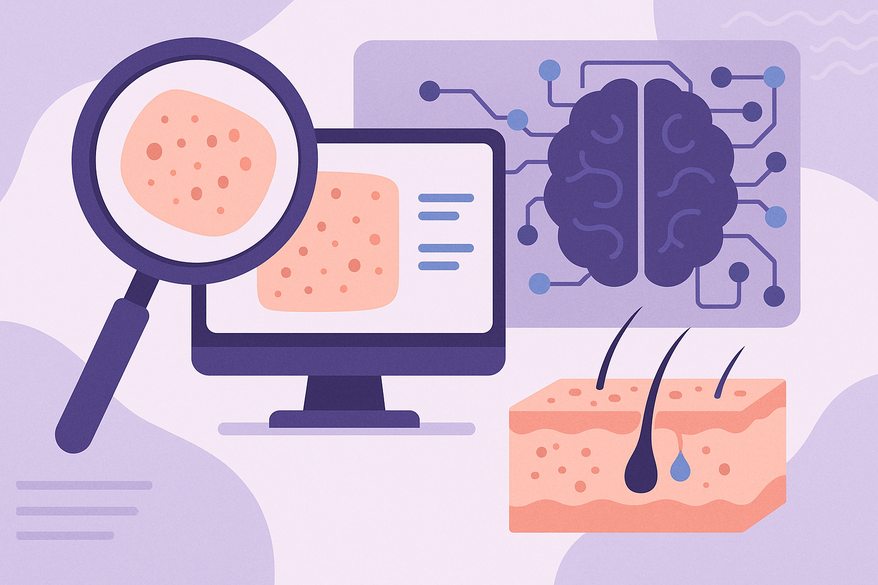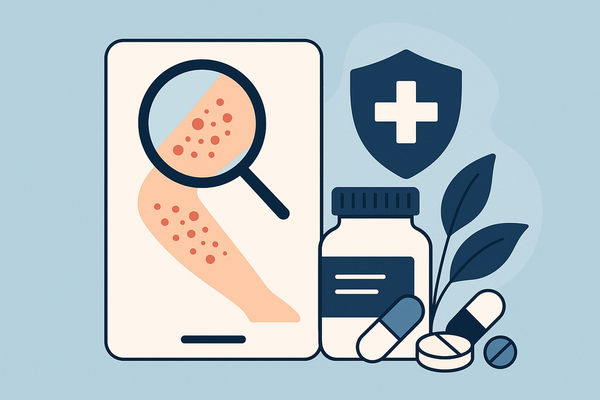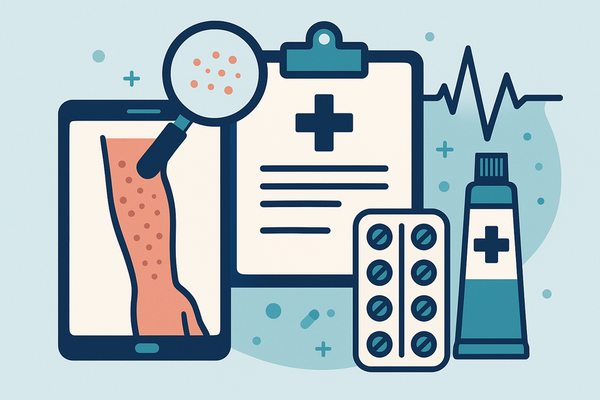Deep Learning for Skin Conditions: Transforming Dermatological Diagnostics
Explore how deep learning for skin conditions is revolutionizing dermatological diagnostics, enhancing accuracy and accessibility in identifying skin issues.

Estimated reading time: 10 min read
Key Takeaways
- Deep learning leverages CNN architectures to analyze dermatological images and diagnose conditions with high accuracy.
- Typical workflow includes data collection, image preprocessing, model training, validation, and inference.
- Benefits include speed, scalability, and remote accessibility via smartphone apps.
- Challenges involve data quality, AI bias, model interpretability, and clinical integration.
- Future innovations focus on multi-modal models, federated learning, explainable AI, and ethical governance.
Table of Contents
- Introduction
- Background on Deep Learning and AI in Healthcare
- Technical Overview: Deep Learning in Dermatology
- Application in Diagnosing Skin Conditions
- Benefits, Limitations, and Challenges
- Future Directions and Innovations
- Conclusion
Introduction
Deep learning for skin conditions refers to the use of multi-layer neural networks to analyze images of the skin and diagnose conditions such as rashes, moles, and skin cancers. With AI in dermatology growing rapidly, machine learning diagnosis tools help fill gaps created by dermatologist shortages (How AI Diagnoses Rashes). Globally, skin disease is a leading cause of non-fatal illness, yet many regions lack enough specialists to meet demand—underscoring the need for automated, accurate image-based diagnostics.
This article provides technical insights into how AI and deep learning diagnose rashes and analyze dermatological images.
Background on Deep Learning and AI in Healthcare
Define Deep Learning
Deep learning is a subset of machine learning where neural networks learn hierarchical patterns from large datasets. In healthcare, these models automatically extract features from complex inputs like medical scans or patient records, enabling predictive analytics and computer vision applications (Machine Learning in Skin Analysis).
Overview of AI/ML Techniques
- Convolutional Neural Networks (CNNs): Excel at extracting shape, color, and texture features from images; power most skin lesion classifiers.
- Ensemble Learning & Multi-Class Classification: Combines predictions from multiple models to improve diagnostic accuracy and robustness.
Why Suited to Dermatology
Dermatology relies on visual examination—patterns in color, texture, and morphology. Deep learning quantifies these visual cues at scale, outperforming traditional rule-based analysis and delivering sensitive, scalable screening.
Technical Overview: Deep Learning in Dermatology
Architectures and Models
- ResNet: Uses residual connections to enable very deep networks (up to 152 layers) without vanishing gradients—ideal for dermoscopic image analysis.
- Inception: Incorporates multi-scale convolutions in parallel branches, capturing diverse feature sizes in clinical photographs.
Variants like DenseNet and EfficientNet underpin state-of-the-art skin condition detectors.
Workflow Steps
- Data Collection:
- Capture images with DSLR cameras, dermatoscopes, or smartphones.
- Record patient metadata (age, sex, lesion location) to enrich training labels.
- Secure informed consent and ensure HIPAA/GDPR compliance.
- Image Preprocessing:
- Normalize pixel intensities to reduce lighting variation.
- Apply augmentation (rotations, flips, color jitter) to expand dataset diversity.
- Resize images to uniform dimensions (e.g., 224×224 px) for CNN input.
- Model Training & Validation:
- Split data: 70% training, 15% validation, 15% test sets.
- Use k-fold cross-validation to assess generalization and avoid overfitting.
- Optimize hyperparameters (learning rate, batch size, epochs) using grid or Bayesian search.
Technical Challenges
- Data Quality Issues: Inconsistent lighting, variable focus, and uneven skin tone representation.
- Image Variation: Device heterogeneity demands robust normalization pipelines.
- Model Interpretability: CNNs often act as “black boxes,” hindering clinical acceptance without explainable AI tools.
Application in Diagnosing Skin Conditions
Diagnostic Pipeline
- Image Capture:
- Acquire high-resolution photos via smartphone or dermatoscope.
- Pre-processing & Inference:
- Normalize and augment images in real time.
- Feed images into a trained CNN to extract hierarchical features (edges, spots, color metrics).
- Model Prediction:
- Compute probabilities for each condition (eczema, psoriasis, melanoma, benign rashes).
- Apply thresholding to balance sensitivity and specificity.
- Decision Support:
- Display predictions on a clinician dashboard or mobile interface.
- Provide heatmaps like Grad-CAM to highlight regions driving the prediction.
Real-World Case Studies
- Smartphone-based multiclass classifier achieved 97.5% accuracy across five common conditions, demonstrating feasibility in primary care settings.
- Models trained on underrepresented populations detect fungal and parasitic skin conditions, addressing equity gaps.
Benefits, Limitations, and Challenges
Benefits
- Speed & Scalability: Instant analysis of thousands of images reduces clinician workload.
- High Accuracy: Early detection of malignant lesions rivals expert dermatologists.
- Accessibility: Smartphone deployment brings screening to remote areas.
Limitations
- Dataset Scarcity: Rare conditions and darker skin tones remain underrepresented.
- AI Bias: Unbalanced training sets introduce performance disparities across demographics.
- Interpretability Gap: Clinicians require transparent reasoning behind AI predictions.
Clinical Integration Challenges
- Workflow Integration: Embedding AI tools into electronic health records and existing protocols.
- Regulatory Approval: FDA and EMA clearance processes demand rigorous trials.
- Data Privacy & Security: Maintaining HIPAA/GDPR compliance for patient data.
- Continuous Monitoring: Models must be retrained with new data to sustain performance.
Future Directions and Innovations
Emerging Trends
- Multi-Modal Models: Fuse images with patient history, lab results, or genomic data for holistic predictions.
- Federated Learning: Train models across institutions without sharing raw patient data.
Algorithmic Improvements
- Explainable AI: Methods like Grad-CAM and LIME provide visual explanations of model decisions.
- Fairness-Aware Training: Use re-weighting and adversarial debiasing to equalize performance across demographics.
Ethical and Regulatory Considerations
- Bias Auditing Standards: Develop transparent metrics and third-party audits to mitigate biases.
- Informed Consent: Clearly communicate AI’s role in diagnosis and secure patient permission for data use.
- Data Governance: Establish protocols for data storage, access control, and anonymization.
Conclusion
Deep learning, powered by CNN architectures, offers accurate, scalable tools for diagnosing skin conditions. From data collection and preprocessing to model training and inference, AI-driven pipelines deliver rapid, image-based diagnostics that support clinicians and expand access. While benefits include speed, high sensitivity, and remote deployment, limitations around dataset scarcity, bias, and interpretability must be addressed.
At-home apps like Rash Detector provide users with instant AI-powered analyses of their own skin images. Below is a sample summary report generated by such a tool:

AI promises to democratize dermatological care, bringing expert-level screening to every corner of the globe. Continued research, diverse data collection, transparent algorithms, and seamless clinical integration are key to realizing its full potential.
FAQ
What is deep learning in dermatological diagnostics?
Deep learning applies multi-layer neural networks to automatically learn features from skin images, enabling accurate classification of conditions like eczema, psoriasis, and melanoma.
How accurate are AI-based skin diagnoses?
State-of-the-art CNN models can match or exceed expert dermatologists in sensitivity and specificity, with some classifiers achieving over 97% accuracy in clinical studies.
Can I use these tools on my smartphone?
Yes. Many AI-powered apps deploy trained models on mobile devices, offering accessible screening and decision support in remote or resource-limited settings.
What privacy measures are in place for patient images?
AI platforms adhere to HIPAA and GDPR standards by encrypting images, anonymizing metadata, and implementing strict access controls.
Will AI replace dermatologists?
AI serves as a decision-support tool to augment clinician workflows, improve triage, and increase screening capacity. It is designed to assist—not replace—medical professionals.





